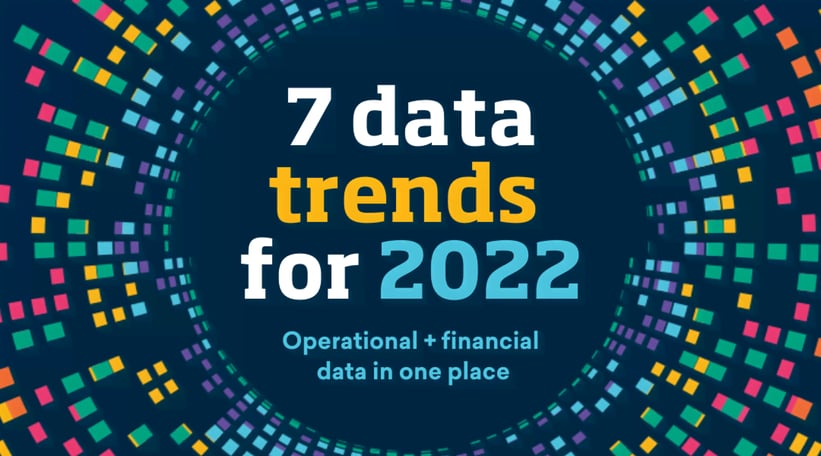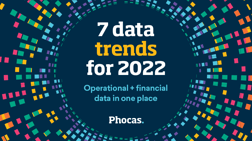The data trends you need to know for 2022

With the new year well underway, it looks like organizations will be facing another roller-coaster year of change. Hybrid workplaces, the ‘Great Resignation’, and flexible employment are just some of the forces transforming the world of work. Businesses that can spot trends early and adapt quickly to the change around them will be the ones to come out on top.
Underlying this ability to move fast is data. Data that is accurate, accessible, and available from anywhere across your entire company. By having a complete view of your business, everyone from sales through to finance can make better decisions and drive better results.
We look at some of the key data and business trends for 2022 – and how they can help you spot trends fast and pivot with confidence.
Finance at the centre of new operating models
If you’re looking to build more value and offer products or services at a competitive cost – then it’s time to commit to new operating models.
These models combine digital technologies and operational capabilities to create new ways of working. And because they rely heavily on financial data, the finance team has now become largely responsible for their design.
With the right next-generation operating model, your organization shift can from siloed data to an integrated data program. By reflecting the needs of all departments, they can help specialists across the business to:
- Access the information they need from the cloud via hybrid working environments
- Budget and forecast collectively with secure workflows
- Communicate remotely about customer issues or supply chain delays
For these new operating models to work, they need to be implemented company-wide. With access to full data sets, different departments can slice and dice data as they need to make better faster decisions.
New metrics: going deeper with analysis
In 2022 – and beyond – organizations will need to go deeper with their analysis. This means delving beyond traditional operational and financial data to get a better understanding of their current working environments and key business drivers.
New metrics on the employee experience is one example. Exceptional employee experiences are now recognized to be inextricably linked to positive customer experiences. Dashboards that go deeper into the employee experience to cover things such as human capital value and variable headcount compensation models can be used to help retain talent, build happier workplaces, and create great customer experiences.
More extended planning and analysis (xP&A), please
The appetite for xP&A is growing, with organizations wanting more of both the planning and the analysis. With more xP&A, organizations can bridge the gap between operational and financial planning so they can integrate budgets and forecasts from across the business.
For this to work, budgeting and forecasting need to be more regular and disciplined. With new budgeting and forecasting tools built on a BI platform, you can collect data from all parts of the business. This allows budgeting to be repeatable, fosters secure collaboration, and helps you see performance impacts across departments.
Post-COVID bounce back requires a good handle on working capital
As the world comes out of a COVID-induced hibernation, many organizations will be making the switch from cost-cutting and survival to the next big challenge of funding and managing growth. With growth bringing its own working capital challenges, monitoring working capital KPIs will be more important than usual.
One of the key challenges here is the time and effort required to calculate working capital ratios to identify trends. Spotting emerging trends in working capital ratios such as inventory turn, days debtors, and days payable, can provide early warning of cash flow squeezes ahead. With financial analytics tools, you can access timely metrics to help you act quickly and decisively, as well as monitor the impact of your decisions as you pursue growth.
Leveraging data from across your business
While no one knows what 2022 will bring, one thing the past few years have reinforced is the need to act quickly to adapt to change. With the right tools to bring your financial and operational data into one source, you can empower teams across your organization to make confident decisions, adapt to change fast, and deliver exceptional experiences.
For more information on these and other xP&A trends, download our free ebook: 7 data trends for 2022

Empowering businesses with intuitive data analytics, driving informed decisions for growth and profitability. We make people feel good about data.

How technology is fixing the finance talent shortage and bringing a renaissance
Accounting is one of the oldest professions, with double-entry bookkeeping tracing back to Roman merchants in the 14th century. And the genius of a system in which every transaction is recorded with an opposite entry in a different account continues to be standard practice. Just as accounting emerged during the shift from the Middle Ages to the Renaissance, today’s finance teams must also adapt to new challenges and opportunities.
Read more
Essential KPIs every distribution company executive should measure
For mid-market leaders running a wholesale distribution business, data and business intelligence technology are crucial for monitoring financial and operational performance. However, the real value lies in how your team uses the data insights to influence decision-making.
Read more
An accurate view of your business’ finances: it’s not too hard to get
Finance teams are increasingly under pressure to provide CEOs and other executives with information related to their business’ current financial scenario — but it’s not always easy for them to do so.
Read more
Cost allocation: why precision matters
It’s a common scenario: you’re out for dinner with friends, and you've enjoyed a nice meal. Now it’s time to split the bill.
Read more
Find out how our platform gives you the visibility you need to get more done.
Get your demo today